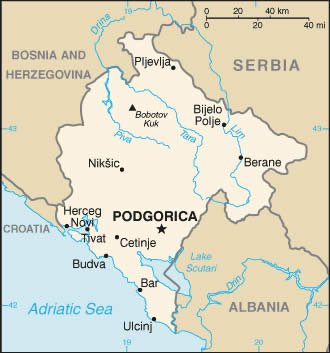 Montenegro
Montenegro
History
In 9 AD the Romans conquered the region of present-day Montenegro. Slavs massively colonized the area in the 5th and 6th centuries, forming a semi-independent principality, Duklja. Duklja gained its independence from the Byzantine Empire in 1042 and expanded its territory. Its power started declining at the ending of the 11th century and it was conquered an incorporated into Serbia. In 1499, Montenegro fell to the Ottomans, who annexed it.
Under Nicholas I, the only king of Montenegro, the Principality of Montenegro gained independence from the Ottoman Empire in 1878. In 1910 Montenegro became a Kingdom. It initiated the Balkan wars in 1912 and 1913 in which the Ottomans lost all lands in the Balkans, achieving a common border with Serbia. In World War I in 1914 Montenegro sided with Serbia against the Central Powers, suffering a full scale defeat to Austria-Hungary in early 1916. In 1918 the Allies liberated Montenegro, which was subsequently merged with Serbia.
In 1922 Montenegro formally became the Zeta Area of the Kingdom of Serbs, Croats and Slovenes, and in 1929 it became a part of the Kingdom of Yugoslavia. In World War II Yugoslavia was invaded by the Axis forces in 1941, who established a puppet Independent State of Montenegro, liberated by the Yugoslav Partisans in 1944. Montenegro became a constituent republic of the communist Socialist Federal Republic of Yugoslavia, its capital renamed to Titograd in honor of the president Josip “Tito” Broz. On the basis of a referendum held on 21 May 2006, Montenegro declared independence on 3 June of that year separating from Serbia.
Church History
Religion is very important to the people of Montenegro. It is considered one of their most distinguishing characteristics. Most Montenegrin are Orthodox, while most Albanians – another ethnic group in Montenegro– are Sunni Muslim. Pentecostal believers from the United States and Europe began evangelism and church planting in Montenegro in the 1930s. After WWII, contact with believers outside the country was difficult because Christians were “watched” very closely.
The Movement Today
Today, Montenegro has one Pentecostal Church located in the capital city of Podgorica. Several Pentecostal church plants are underway in various parts of the country. The number of Montenegrin Christians is now about 300.
Additional Facts About Montenegro
- Capital: Podgorica
- Area: 5,332 square miles
- Population: 620,000
- Urbanization: 63%
- Ethnic Groups: Montenegrins 45%, Serbs 29%, Bosniaks 9%, Albanians 5%, Ethnic Muslims 3%, Others 9%
- Languages: Serbian 43%, Montenegrin 37%, Bosnian 5%, Albanian 5%, Serbo-Croatian 2%, Other 8%
- Agriculture: Cereals, fruits, and vegetables
- Economy: Aluminum, Steel, agricultural processing, and tourism




